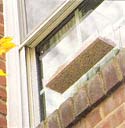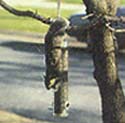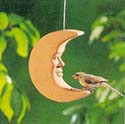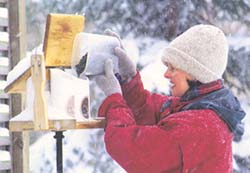Bird Feeder Selection
When the ground is covered with snow and ice, it’s hard to resist just tossing seed out the door. But it’s healthier for the birds to get their handouts at a feeding station, rather than off the ground. Regardless of the season, food that sits on the ground for even a short time is exposed to contamination by dampness, mold, bacteria, animal droppings, lawn fertilizers, and pesticides.
You can start simply with a piece of scrap wood elevated a few inches above the ground. Add a few holes for, drainage and you’ve built a platform feeder. It won’t be long before the birds find it.
Placement
There are several factors to consider after you’ve decided to feed birds in your backyard.
Where do you want to watch your birds? From a kitchen window … a sliding glass door opening onto a deck … a second-story window?

Pick a location that is easy to get to. When the weather is bad and birds are most vulnerable, you may be reluctant to fill a feeder that is not in a convenient spot near a door or an accessible window. Also, pick a site where discarded seed shells and bird droppings won’t be a cleanup problem. Put your feeder where the squirrels can’t reach. Squirrels become a problem when they take over a bird feeder, scaring the birds away and tossing seed all over. Squirrels have been known to chew right through plastic and wooden feeders.
If you’ve seen squirrels in your neighborhood, it is safe to assume they will visit your feeder. Think long and hard before you hang anything from a tree limb. Squirrels are incredibly agile, and any feeder hanging from a tree is likely to become a squirrel feeder.

In the long run, a squirrel-proof feeder or any feeder on a pole with a baffle is the least aggravating solution. The most effective squirrel-proof feeder is the pole-mounted metal “house” type.
If you must hang a feeder, select a tube protected with metal mesh. Most plastic “squirrel-proof ” feeders, despite manufacturers’ claims, may eventually succumb to the squirrels. Any wood or plastic feeder can be effective when mounted on a pole with a plastic or metal baffle if the pole is at least 10 feet or more from a tree limb or trunk (squirrels can jump great distances).
Durability
Bird feeders are made from a variety of materials. You can buy disposable plastic bag feeders; feeders made of cloth, nylon, vinyl, and metal netting; clear, lexan, colored and PVC plastic tubes; ceramic and terra cotta; redwood, western cedar, birch, pine, and plywood; sheet metal and aluminized steel; glass tubes and bottles.

How long a feeder lasts depends on how well you maintain it, the effects of weather, and whether squirrels can get to it. Water can get into any feeder regardless of how carefully you protect it. Cloth, vinyl, nylon, and metal netting feeders are inexpensive, but they do not protect your seed from spoiling in damp or wet weather. Improve them by adding a plastic dome.
Most wood, plastic, ceramic and solid metal feeders keep seed dry, but water can get into the feeding portals. Look for feeders with drainage holes in the bottoms of both the feeder hopper and the seed tray.
Even bowl-type feeders and trays with drainage holes will clog with seed and bird droppings that can mix with rainwater and be unhealthy for any animal. Look for shallow plate-like seed trays to catch dropped seeds while allowing spent seed shells to blow away.
When you feed birds, expect bird droppings and a leftover food mess. While you do not have to wash the feeder daily, you should clean it at least every few weeks. Diseases like salmonella can grow in moldy, wet seed and bird droppings in your feeder tray and on the ground below. Move your feeder a few feet each season to give the ground underneath time to assimilate the seed debris and bird droppings.
The maintenance required to keep your feeder clean varies according to the type of feeder. A thistle feeder for goldfinches should be cleaned about once a month depending on how often it rains. Feeding hummingbirds require cleaning at the very least weekly, but preferably two or three times a week. Sunflower and suet feeders need to be cleaned only once a month.
Plastic, ceramic and glass feeders are easy to clean. Wash them in a bucket of hot, soapy water fortified with a capful or two of chlorine bleach. Use the same regimen with wood feeders, but substitute another disinfectant for the bleach so your wood won’t fade.
Food Capacity
The ideal feeder capacity varies with your situation, and the types of birds you want to attract. If you feed hummingbirds, big feeders are not always better. One hummingbird will drink about twice its body weight (less than an ounce) a day. Early in the season, hummers are territorial and won’t share a feeder. A sixteen-ounce feeder can be wasteful, or even lethal because artificial nectar (sugar water) can ferment in the hot summer sun. A two-ounce feeder is more than enough for one hummer. Increase the size of your feeder depending on your location and how many hummers you see in your yard.

If you opt for a large-volume seed feeder, protect it from the weather and keep it clean. If after months of use, the birds suddenly abandon your feeder full of seed, it’s time for a cleaning.
Other Links:
- For the birds
- Back yard bird feeding
- Bird Feeder Selection
- How Many Birds
- Birds Attracted by Various Feeders and Foods
- Uninvited Guests at the Birdfeeder
- Questions about Feeding Wild Birds
- Homes for Birds
- Selecting a Bird House
- Bird House Design
- Bird Nest Box Dimensions
- Bird House Placement
- Protection from Predators
- Attracting Birds
- Landscaping for Birds
- Basics of Landscaping for Birds
- Plants for Wild Birds
- How to Get Started
- Protecting Bird Habitat
- Additional Readings
